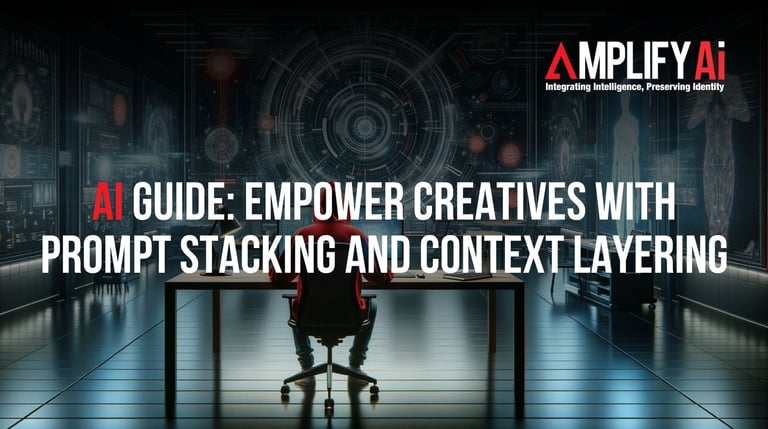AI Guide: Empower Creatives with Prompt Stacking and Context Layering
Ronsley Vaz
6 min read


You know how the world of AI is like a rollercoaster, constantly throwing new twists and turns our way? Well, two game-changers that are making some serious waves are prompt stacking and context layering. These aren't just buzzwords; they're your keys to unlocking AI's true potential. Imagine them as the secret spices that turn your AI from bland to mind-blowingly tasty. If you're a creative entrepreneur or running a small biz, sit tight. We're diving deep into what these terms mean and, more importantly, how they can revolutionise the way you do business. Trust me, this is stuff you'll want to know.
A. Definition of Prompt Stacking & Context Layering
So, ever heard of prompt stacking and context layering in AI? Let's break it down in a way that makes sense, shall we? Prompt stacking is like giving your AI a GPS route with multiple stops. You're feeding it a sequence of questions or tasks that help it understand what you're really after. It's not just about saying, "Hey, tell me something interesting"; it's like saying, "Tell me an interesting fact about the history of jazz music in the 1920s." The more specific you are, the better the AI can navigate the complexities and give you a meaningful answer.
Now, let's talk context layering. Imagine you're working on a layered cake, and each layer adds a new flavor. That's what context layering does for AI. It's like giving your AI extra spices and flavors—more background info—to help it make sense of what you're asking. The richer the context, the more nuanced and informed the AI's responses will be.
Put these two techniques together, and what do you get? An AI system that not only understands your questions but also offers insights that are both deep and relevant. It's like having a super-smart buddy who not only listens but also really gets you.
B. Importance and Relevance of Understanding This Topic
For creative entrepreneurs and small business owners, gaining a firm grasp of prompt stacking and context layering is not merely a technicality; it's a strategic imperative. These techniques serve as the cornerstone for unlocking the full potential of AI tools and technologies. By mastering these methods, you can create more interactive experiences, enhance user engagement, and automate various aspects of your business operations, ultimately giving you a competitive edge in today's fast-paced business landscape.
C. The Impact of This Topic for Small Businesses and Solopreneurs
The impact of prompt stacking and context layering techniques on small businesses and solopreneurs cannot be overstated. When harnessed effectively, these techniques can substantially boost productivity and efficiency in various aspects of business operations. Imagine the possibilities: AI-driven chatbots providing personalised customer support, automation of repetitive tasks, and streamlined workflows. With these methods at your disposal, you can save time, enhance customer experiences, and offer more personalised services, all of which contribute to the growth and success of your enterprise.
Basic Concepts
First Principle 1: Sequential Processing
The first principle underpinning prompt stacking and context layering is sequential processing. AI systems read and understand text in a step-by-step, sequential manner. This sequential processing is akin to following a well-structured recipe or building a complex Lego tower, with each step preparing the AI system for the next.
Imagine a chef meticulously following a recipe's instructions. The sequence in which ingredients are added and the specific steps taken all contribute to the final, delectable dish. Similarly, AI systems must process information in a systematic order to generate meaningful and accurate responses to queries.
First Principle 2: Contextual Understanding
Contextual understanding is another essential principle in prompt stacking and context layering. AI systems use surrounding information and context to comprehend the current input and generate appropriate responses. It's akin to a detective piecing together a puzzle using a set of clues to form a complete picture.
Picture a detective examining a crime scene. The detective must consider various elements, such as the location, evidence, and witnesses' statements, to develop a coherent theory of what happened. In the same way, AI systems rely on context to make sense of the information they receive and produce contextually relevant responses.
First Principle 3: Dynamic Adaptation
The third fundamental principle is dynamic adaptation. AI systems can adjust their responses based on new data and information. Think of it as a GPS recalculating a route in real-time based on traffic updates. AI systems, too, can adapt and refine their outputs to meet specific requirements and changes in the environment.
Imagine you're driving to a destination, but you encounter unexpected roadblocks or detours. A reliable GPS system would recalculate the route to help you reach your destination efficiently, despite the unforeseen obstacles. Similarly, AI systems can adjust their responses based on the evolving context and requirements to ensure the best possible outcomes.
Key Components or Elements
Input Prompts:
Input prompts form the initial query or statement used to initiate the AI system's processing. The specificity and detail of the input prompts significantly influence the AI system's ability to understand and respond to the request accurately. It's like providing a clear starting point in a treasure hunt, guiding the AI system towards the desired outcome.
Consider input prompts as the questions you pose to the AI system. The more precise and detailed your questions, the more targeted and accurate the responses will be. Effective input prompts lay the foundation for successful interaction with AI systems.
Context Layers:
Context layers are additional pieces of information that provide guidance and context to AI systems. These layers help AI systems generate more accurate and relevant responses by considering specific factors or constraints. Think of context layers as adding weights to balance a scale, ensuring that the AI system's responses align with the desired outcomes.
Context layers enrich the AI system's understanding of the situation. They can include historical data, user preferences, industry-specific knowledge, or any other pertinent information that helps the AI system make informed decisions. The more context layers you provide, the deeper and more nuanced the AI system's responses become.
Output:
The output is the generated result based on the input prompts and context layers. It represents the final brushstroke of a painting or the GPS-guided journey's endpoint. The output is the culmination of the AI system's processing, reflecting its understanding and decision-making based on the input prompts and context layers.
The output serves as the answer, solution, or recommendation provided by the AI system. It can also serve as an input for subsequent iterations, enabling recursive refinement and continuous improvement in the AI system's responses.
Applications and Use Cases
Prompt stacking and context layering techniques have a wide range of applications across various industries. These methods can transform the way creative entrepreneurs and small business owners operate and innovate. Here are a few examples of how these techniques can be applied in real-life scenarios:
Content Creation:
Content creators can leverage prompt stacking and context layering to streamline and enhance their content creation processes. By providing specific instructions and context, AI systems can assist in generating high-quality articles, blog posts, or social media content. Additionally, these techniques can aid in ideation, brainstorming, and even the creation of complete email nurture sequences, making content generation more efficient and creative.
Consider the case of a marketing team tasked with producing engaging blog posts. With prompt stacking and context layering, AI can assist by providing topic suggestions, outlines, and even relevant statistics and data, significantly reducing the time and effort required for research and content generation.
Product Development:
AI can be a valuable asset in product development, and prompt stacking and context layering can play a pivotal role in this process. Entrepreneurs and small business owners can utilise these techniques to refine product ideas, create comprehensive product outlines, and generate marketing materials. AI can provide insights, suggestions, and contextually relevant information, empowering businesses to make informed decisions and bring innovative products to market.
Imagine a small business aiming to launch a new line of eco-friendly home products. With AI assistance, prompt stacking and context layering can help in generating sustainable product ideas, creating detailed product specifications, and producing compelling marketing materials that resonate with environmentally conscious consumers.
Business Optimisation:
Business optimisation is another domain where prompt stacking and context layering techniques shine. Small businesses can enhance various aspects of their operations, leading to improved efficiency and customer satisfaction. AI-powered chatbots, for example, can be trained using prompt stacking and context layering to provide personalised customer support, automate repetitive tasks, and streamline workflows.
Consider a small e-commerce business managing customer inquiries. By implementing AI chatbots with prompt stacking and context layering, the business can offer customers quick and personalised responses, handle routine order tracking requests, and even recommend complementary products based on customer preferences. This not only enhances customer satisfaction but also frees up human resources to focus on more complex tasks.
Prompt stacking and context layering are transformative techniques that enable AI systems to process and generate text more effectively. Understanding and utilising these techniques is more than just an advantage; it's a strategic imperative in today's AI-driven landscape.
By incorporating prompt stacking and context layering into your AI strategies, you can harness the full potential of AI technologies to grow your business and stay ahead of the competition. These techniques empower you to enhance productivity, improve user experiences, and offer personalised services that set you apart in the dynamic world of entrepreneurship and small business ownership.
Look, AI isn't slowing down, and neither should you. Keeping your finger on the pulse of these techniques is your golden ticket to long-term innovation and success. So, let's start treating AI not just as a tool but as a business partner. Embrace prompt stacking and context layering, and watch as new doors swing open for your creative projects and business ambitions.
Subscribe to the podcast
Subscribe now to "Amplify Ai" and let's set sail together on this exciting voyage towards business growth and success.



